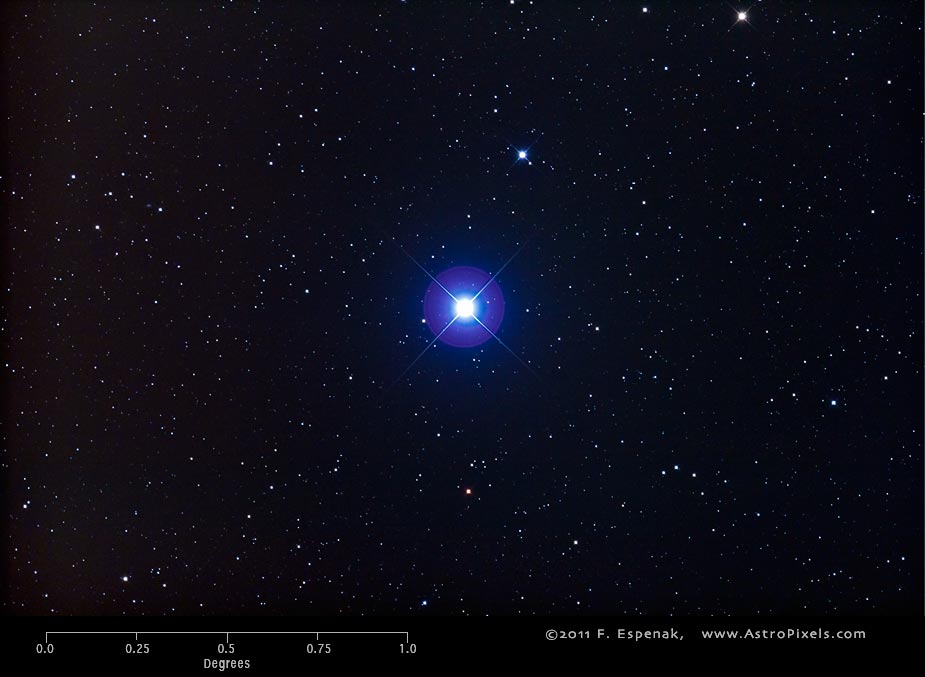Fomalhaut
Fomalhaut or Alpha Piscis Austrini (Alp PsA) is the brightest naked eye star in the constellation Piscis Austrinus. With an apparent magnitude of 1.17, Fomalhaut is the 18th brightest star in the entire sky (see: 50 Brightest Stars ). Its absolute magnitude is 1.74 and its distance is 25.1 light years.The Equinox J2000 equatorial coordinates are RA = 22h 57m 39.1s, Dec = -29° 37' 20".
Fomalhaut has a spectral type of A3V, a surface temperature of 8750° Kelvin and a luminosity 17.9 times the Sun. It has a mass of 2.1 solar masses and a diameter 1.8 times the Sun.
The image above shows the uncropped view of Fomalhaut (North is up) through the Takahashi E-180 Astrograph.
Fomalhaut is a young star between 100 to 300 million years old, with a potential lifespan of a billion years. It is metal-deficient as compared to the Sun, which means it is composed of a smaller percentage of elements other than hydrogen and helium. The metallicity is typically determined by measuring the abundance of iron in the photosphere relative to the abundance of hydrogen. A 1997 spectroscopic study measured a value equal to 93% of the Sun's abundance of iron but more recent observations suggest the value may actually be half as much.
Fomalhaut is a member of the 16 stars belonging to the Castor Moving Group. This an association of stars that share a common motion through space and are therefore likely to be physically associated. Other members of this group include Castor and Vega. This moving group has an estimated age of 200 million years and originated from the same location. The nearby star TW Piscis Austrini, a member of this group, may form a physical pair with Fomalhaut.Fomalhaut is surrounded by a debris disk of dust in a toroidal shape with a very sharp inner edge at a radial distance of 133 AU, inclined 24 degrees from edge-on. The dust is distributed in a belt about 25 AU wide and is sometimes referred to as "Fomalhaut's Kuiper belt". Fomalhaut's dusty disk is believed to be protoplanetary, and emits considerable infrared radiation. Measurements of Fomalhaut's rotation indicate that the disk is located in the star's equatorial plane, as expected from theories of star and planet formation.
Fomalhaut holds a special significance in extrasolar planet research, as it is the center of the first stellar system with an extrasolar planet (Fomalhaut b) imaged at visible wavelengths. The mass of the planet is estimated to be no more than three times the mass of Jupiter and at least the mass of Neptune. Fomalhaut is the third brightest star known to have an orbiting planet, after Pollux and the Sun.
The description above is based on the Fomalhaut entry in Wikipedia.For more information about Fomalhaut, see Stars (Jim Kaler).
Technical Details
- Object: Fomalhaut
- Other Names: Alpha Piscis Austrini, HR8728, HD216956, HIP113368
- Object Type: bright star
- Object Data: Apparent Magnitude = 1.17, Absolute Magnitude = 1.74, distance = 25.1 light years
- Object Position (Equinox J2000): RA = 22h 57m 39.1s, Dec = -29° 37' 20", Constellation = Piscis Austrinus
- Date/Time: 2011 Oct 21 at 05:16:11 UTC
- Location: Bifrost Astronomical Observatory, Portal, AZ
- Mount: Astro-Physics 1200GTO
- Telescope: Takahashi Epsilon 180 Hyperbolic Astrograph
- Camera: Canon EOS 550D (Rebel T2i) (modified with a Baader UV/IR filter)
- Field of View: 1.70° x 2.56° at 1.7 arc-sec/pixel (web version: 10.0 arc-sec/pixel)
- Exposure: 2 x 300s, f/2.8, ISO 800
- File Name: Fomalhaut-01w.jpg
- Processing (Adobe Camera Raw): Graduated Filter, Vignetting Correction, Noise Reduction, White Balance, Curves
- Processing (Photoshop CS5): Average Images, Curves, Noise Reduction
- Original Image Size: 3454 × 5179 pixels (17.9 MP); 11.5" x 17.3" @ 300 dpi
- Rights: Copyright 2011 by Fred Espenak. All Rights Reserved. See: Image Licensing.
